CHEVROLET S10 2004 Owners Manual
Manufacturer: CHEVROLET, Model Year: 2004, Model line: S10, Model: CHEVROLET S10 2004Pages: 422, PDF Size: 4.16 MB
Page 101 of 422
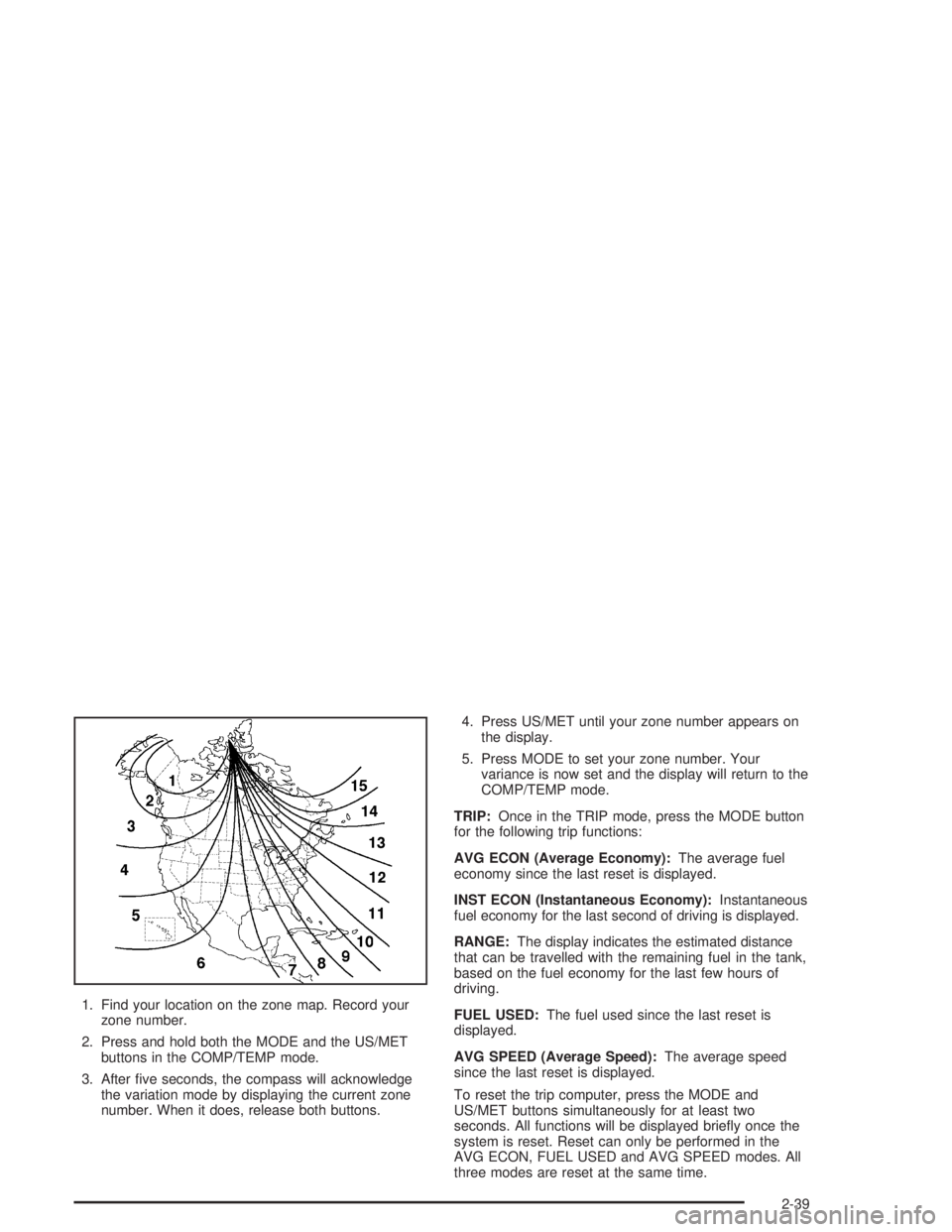
1. Find your location on the zone map. Record your
zone number.
2. Press and hold both the MODE and the US/MET
buttons in the COMP/TEMP mode.
3. After five seconds, the compass will acknowledge
the variation mode by displaying the current zone
number. When it does, release both buttons.4. Press US/MET until your zone number appears on
the display.
5. Press MODE to set your zone number. Your
variance is now set and the display will return to the
COMP/TEMP mode.
TRIP:Once in the TRIP mode, press the MODE button
for the following trip functions:
AVG ECON (Average Economy):The average fuel
economy since the last reset is displayed.
INST ECON (Instantaneous Economy):Instantaneous
fuel economy for the last second of driving is displayed.
RANGE:The display indicates the estimated distance
that can be travelled with the remaining fuel in the tank,
based on the fuel economy for the last few hours of
driving.
FUEL USED:The fuel used since the last reset is
displayed.
AVG SPEED (Average Speed):The average speed
since the last reset is displayed.
To reset the trip computer, press the MODE and
US/MET buttons simultaneously for at least two
seconds. All functions will be displayed briefly once the
system is reset. Reset can only be performed in the
AVG ECON, FUEL USED and AVG SPEED modes. All
three modes are reset at the same time.
2-39
Page 102 of 422
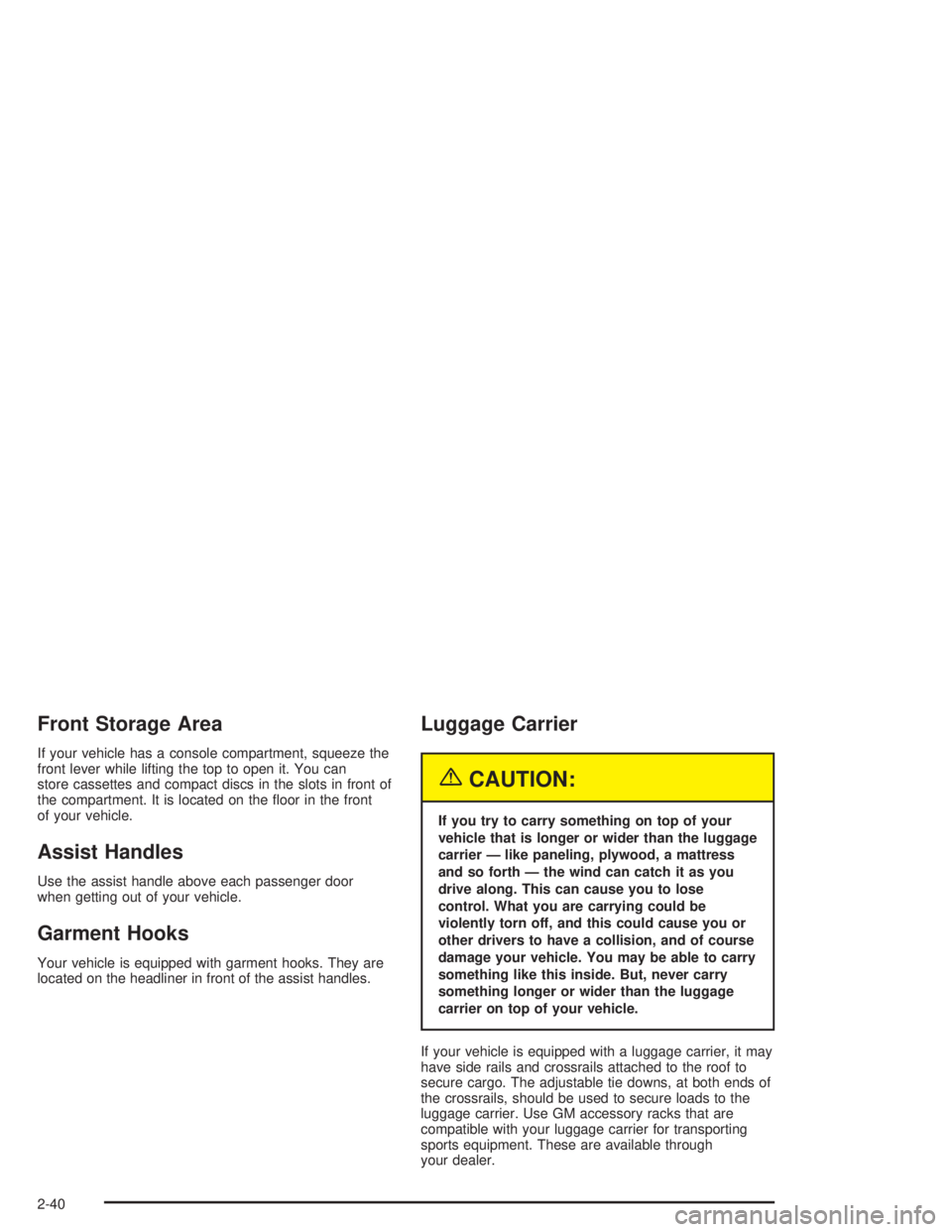
Front Storage Area
If your vehicle has a console compartment, squeeze the
front lever while lifting the top to open it. You can
store cassettes and compact discs in the slots in front of
the compartment. It is located on the floor in the front
of your vehicle.
Assist Handles
Use the assist handle above each passenger door
when getting out of your vehicle.
Garment Hooks
Your vehicle is equipped with garment hooks. They are
located on the headliner in front of the assist handles.
Luggage Carrier
{CAUTION:
If you try to carry something on top of your
vehicle that is longer or wider than the luggage
carrier — like paneling, plywood, a mattress
and so forth — the wind can catch it as you
drive along. This can cause you to lose
control. What you are carrying could be
violently torn off, and this could cause you or
other drivers to have a collision, and of course
damage your vehicle. You may be able to carry
something like this inside. But, never carry
something longer or wider than the luggage
carrier on top of your vehicle.
If your vehicle is equipped with a luggage carrier, it may
have side rails and crossrails attached to the roof to
secure cargo. The adjustable tie downs, at both ends of
the crossrails, should be used to secure loads to the
luggage carrier. Use GM accessory racks that are
compatible with your luggage carrier for transporting
sports equipment. These are available through
your dealer.
2-40
Page 103 of 422
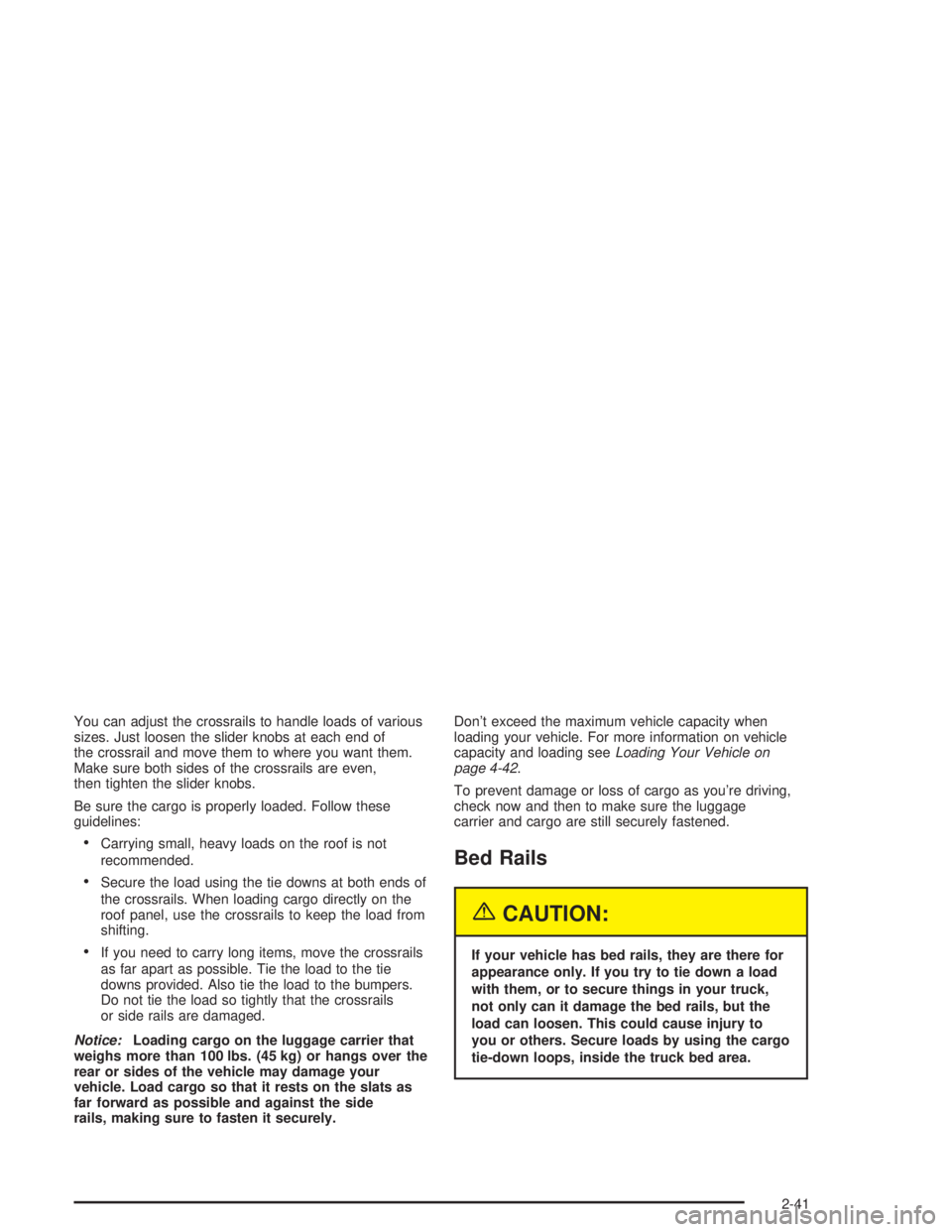
You can adjust the crossrails to handle loads of various
sizes. Just loosen the slider knobs at each end of
the crossrail and move them to where you want them.
Make sure both sides of the crossrails are even,
then tighten the slider knobs.
Be sure the cargo is properly loaded. Follow these
guidelines:
•Carrying small, heavy loads on the roof is not
recommended.
•Secure the load using the tie downs at both ends of
the crossrails. When loading cargo directly on the
roof panel, use the crossrails to keep the load from
shifting.
•If you need to carry long items, move the crossrails
as far apart as possible. Tie the load to the tie
downs provided. Also tie the load to the bumpers.
Do not tie the load so tightly that the crossrails
or side rails are damaged.
Notice:Loading cargo on the luggage carrier that
weighs more than 100 lbs. (45 kg) or hangs over the
rear or sides of the vehicle may damage your
vehicle. Load cargo so that it rests on the slats as
far forward as possible and against the side
rails, making sure to fasten it securely.Don’t exceed the maximum vehicle capacity when
loading your vehicle. For more information on vehicle
capacity and loading seeLoading Your Vehicle on
page 4-42.
To prevent damage or loss of cargo as you’re driving,
check now and then to make sure the luggage
carrier and cargo are still securely fastened.
Bed Rails
{CAUTION:
If your vehicle has bed rails, they are there for
appearance only. If you try to tie down a load
with them, or to secure things in your truck,
not only can it damage the bed rails, but the
load can loosen. This could cause injury to
you or others. Secure loads by using the cargo
tie-down loops, inside the truck bed area.
2-41
Page 104 of 422
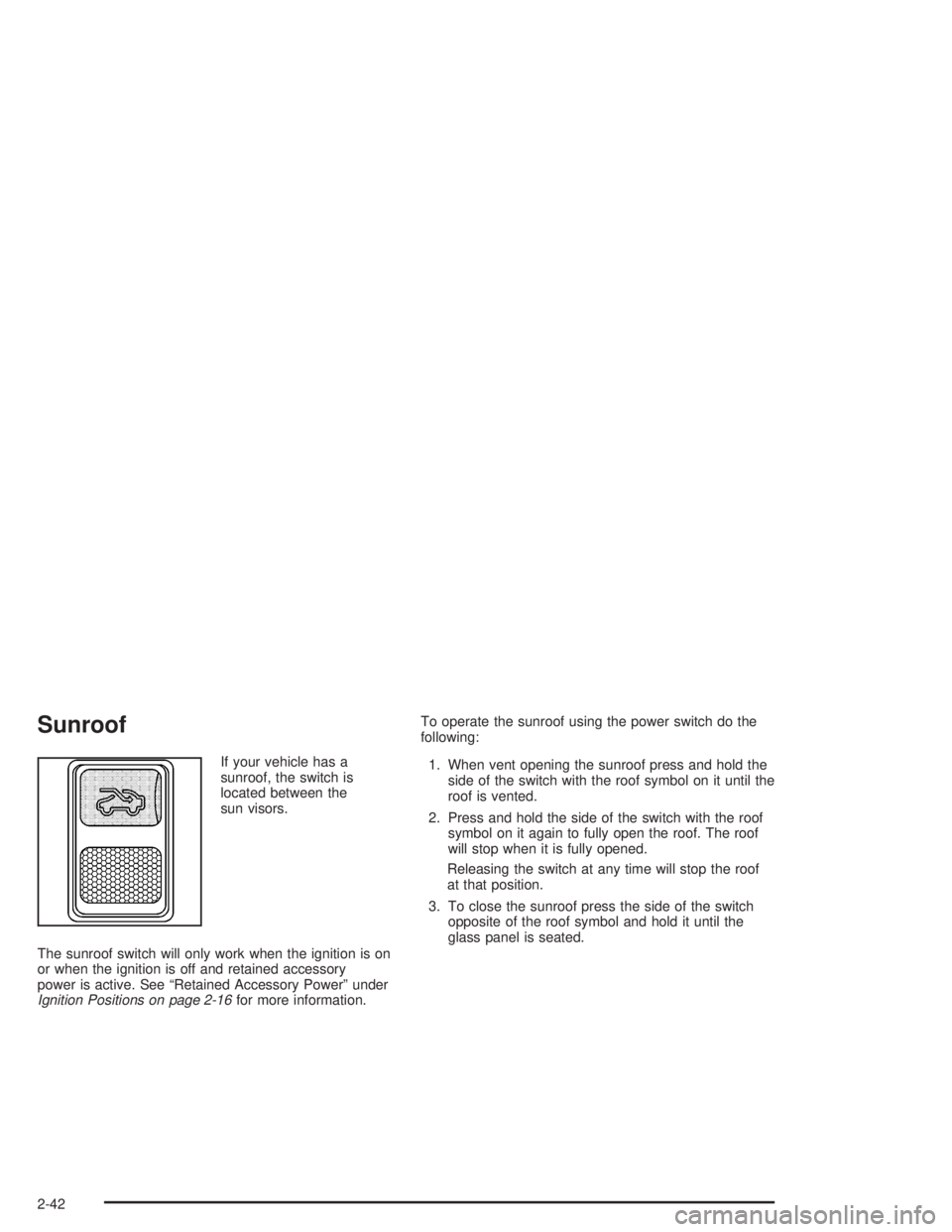
Sunroof
If your vehicle has a
sunroof, the switch is
located between the
sun visors.
The sunroof switch will only work when the ignition is on
or when the ignition is off and retained accessory
power is active. See “Retained Accessory Power” under
Ignition Positions on page 2-16for more information.To operate the sunroof using the power switch do the
following:
1. When vent opening the sunroof press and hold the
side of the switch with the roof symbol on it until the
roof is vented.
2. Press and hold the side of the switch with the roof
symbol on it again to fully open the roof. The roof
will stop when it is fully opened.
Releasing the switch at any time will stop the roof
at that position.
3. To close the sunroof press the side of the switch
opposite of the roof symbol and hold it until the
glass panel is seated.
2-42
Page 105 of 422
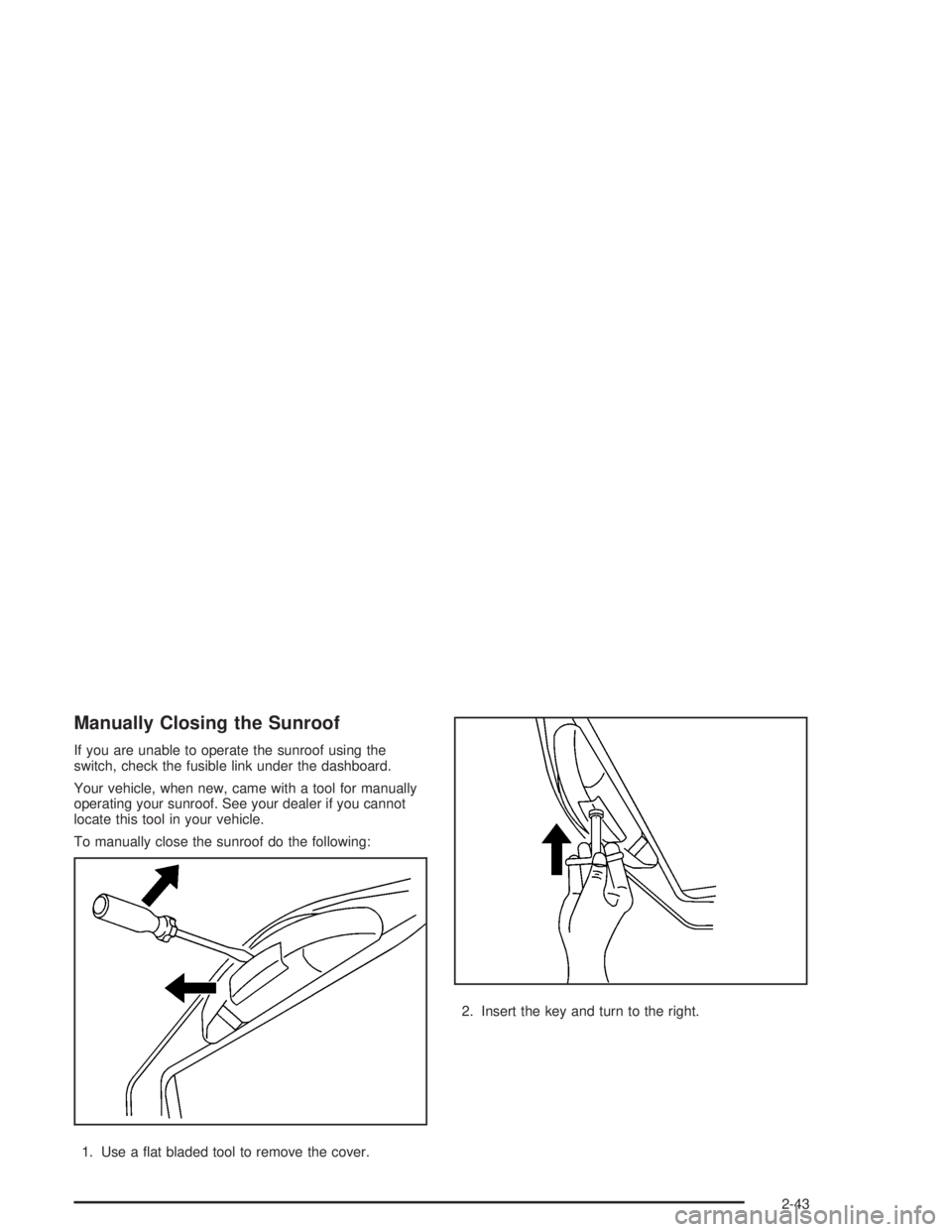
Manually Closing the Sunroof
If you are unable to operate the sunroof using the
switch, check the fusible link under the dashboard.
Your vehicle, when new, came with a tool for manually
operating your sunroof. See your dealer if you cannot
locate this tool in your vehicle.
To manually close the sunroof do the following:
1. Use a flat bladed tool to remove the cover.2. Insert the key and turn to the right.
2-43
Page 106 of 422

✍NOTES
2-44
Page 107 of 422

Instrument Panel Overview...............................3-2
Hazard Warning Flashers................................3-4
Other Warning Devices...................................3-5
Horn.............................................................3-5
Tilt Wheel.....................................................3-5
Turn Signal/Multifunction Lever.........................3-6
Exterior Lamps.............................................3-12
Interior Lamps..............................................3-15
Accessory Power Outlets...............................3-17
Ashtrays and Cigarette Lighter........................3-18
Climate Controls............................................3-18
Climate Control System.................................3-18
Outlet Adjustment.........................................3-21
Warning Lights, Gages and Indicators.............3-22
Instrument Panel Cluster................................3-23
Speedometer and Odometer...........................3-25
Trip Odometer..............................................3-25
Tachometer.................................................3-25
Safety Belt Reminder Light.............................3-25
Air Bag Readiness Light................................3-26
Charging System Light..................................3-27
Voltmeter Gage............................................3-27
Brake System Warning Light..........................3-28
Anti-Lock Brake System Warning Light.............3-29
Engine Coolant Temperature Gage..................3-29
Malfunction Indicator Lamp.............................3-30Oil Pressure Gage........................................3-33
Security Light...............................................3-34
Service Four-Wheel Drive Warning Light..........3-34
Check Gages Warning Light...........................3-35
Fuel Gage...................................................3-35
Low Fuel Warning Light.................................3-36
Audio System(s).............................................3-36
Setting the Time for Radios without Radio
Data Systems (RDS)..................................3-37
Setting the Time for Radios with Radio
Data Systems (RDS)..................................3-37
AM-FM Radio...............................................3-38
Radio with CD..............................................3-41
Radio with Cassette and CD..........................3-51
Radio with Six-Disc CD.................................3-61
Theft-Deterrent Feature
(Non-RDS Radios).....................................3-75
Theft-Deterrent Feature
(RDS Radios)...........................................3-75
Understanding Radio Reception......................3-76
Care of Your Cassette Tape Player.................3-76
Care of Your CDs.........................................3-77
Care of Your CD Player................................3-78
Fixed Mast Antenna......................................3-78
XM™ Satellite Radio Antenna System
(48 Contiguous US States).........................3-78
Section 3 Instrument Panel
3-1
Page 108 of 422
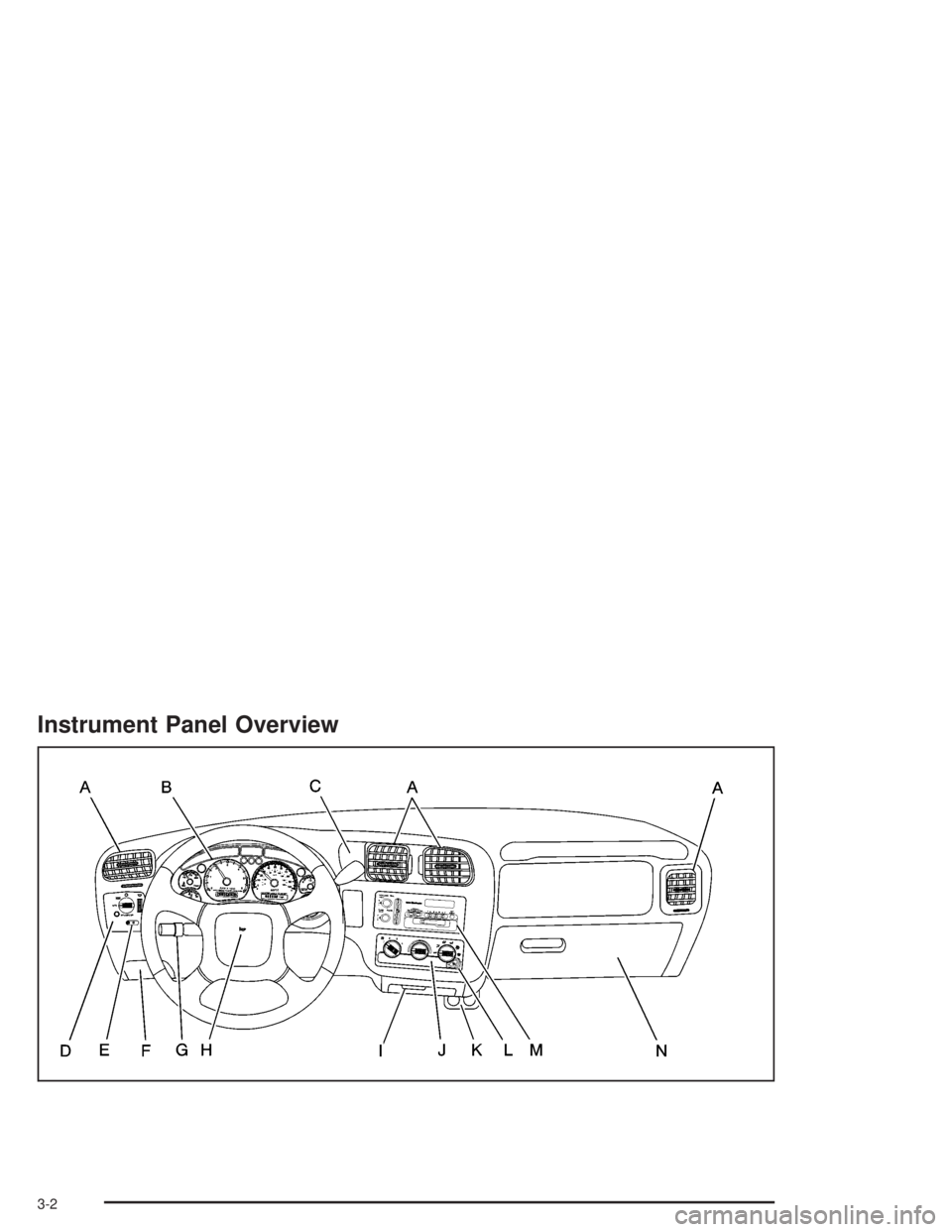
Instrument Panel Overview
3-2
Page 109 of 422

The main components of your vehicle’s instrument panel are the following:
A. Air Outlets. SeeOutlet Adjustment on page 3-21for
more information.
B. Instrument Panel Cluster. SeeInstrument Panel
Cluster on page 3-23for more information.
C. Electronic Transfer Case Switch. See “Transfer
Case” underFour-Wheel Drive on page 5-50
for more information.
D. Lamp Controls. SeeExterior Lamps on page 3-12
for more information.
E. Fog Lamp Button. See “Fog Lamps” underExterior
Lamps on page 3-12for more information.
F. Brake Release. SeeParking Brake on page 2-25for
more information.
G. Turn Signal/Multifunction Lever. SeeTurn
Signal/Multifunction Lever on page 3-6for more
information.H. Horn. SeeHorn on page 3-5for more information.
I. Ashtray. SeeAshtrays and Cigarette Lighter on
page 3-18for more information.
J. Climate Controls. SeeClimate Control System on
page 3-18for more information.
K. Accessory Power Outlets. SeeAccessory Power
Outlets on page 3-17for more information.
L. Heated Outside Rearview Mirror Button (If
Equipped). SeeOutside Heated Mirrors on
page 2-33for more information.
M. Audio System. SeeAudio System(s) on page 3-36
for more information.
N. Glove Box. SeeGlove Box on page 2-33for more
information.
3-3
Page 110 of 422
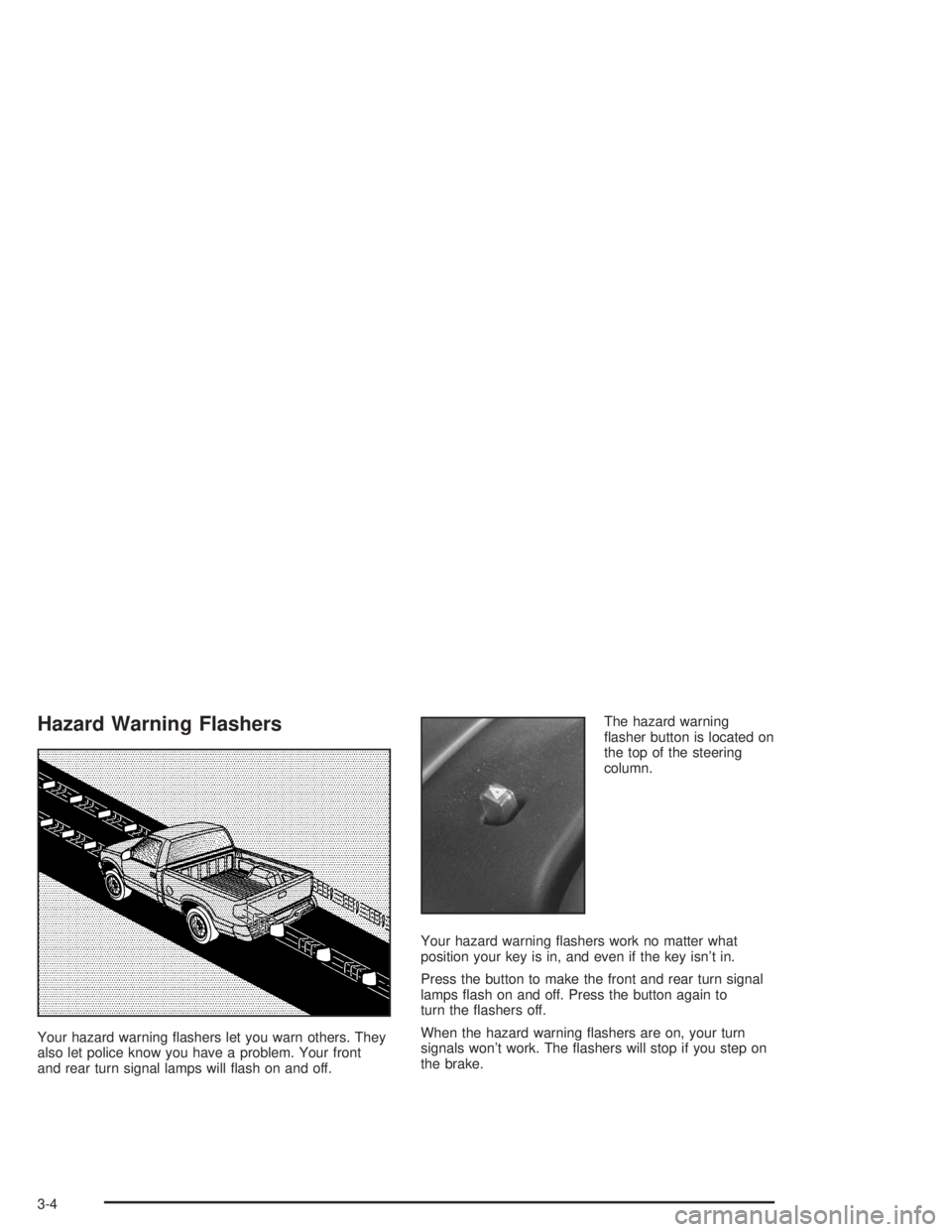
Hazard Warning Flashers
Your hazard warning flashers let you warn others. They
also let police know you have a problem. Your front
and rear turn signal lamps will flash on and off.The hazard warning
flasher button is located on
the top of the steering
column.
Your hazard warning flashers work no matter what
position your key is in, and even if the key isn’t in.
Press the button to make the front and rear turn signal
lamps flash on and off. Press the button again to
turn the flashers off.
When the hazard warning flashers are on, your turn
signals won’t work. The flashers will stop if you step on
the brake.
3-4